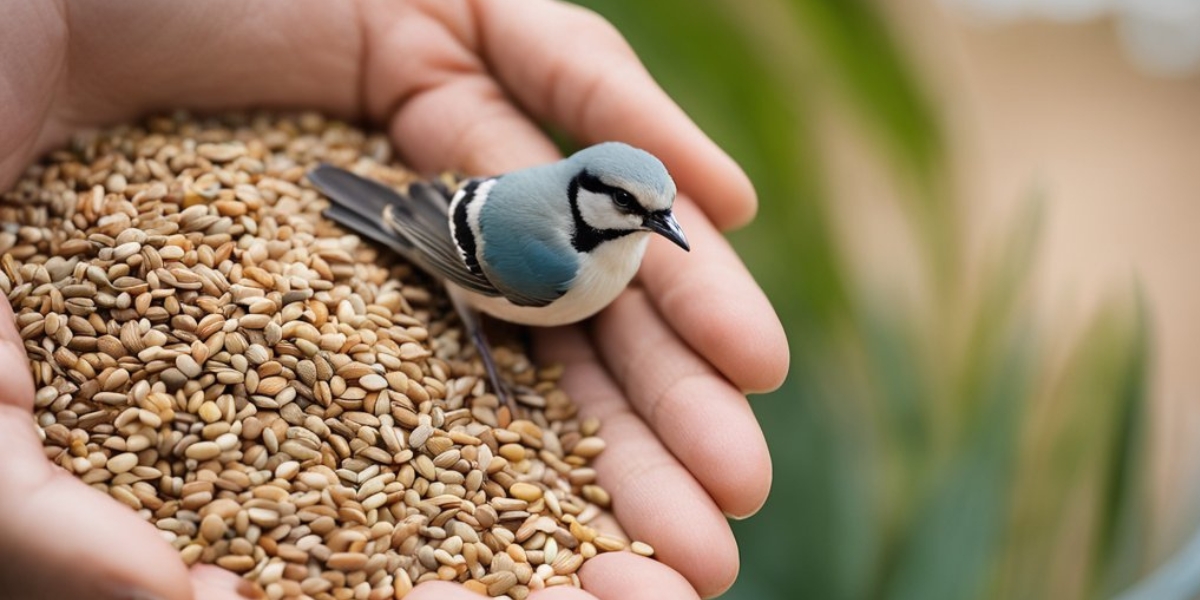Hand-feeding wild birds is a special experience that forms a powerful human-bird connection. With patience and the right approach, you can train backyard birds to eat directly from your hand. Getting inquisitive chickadees, cardinals, finches, and other species to perch on your fingers and take food is extremely rewarding. Follow this guide to learn how to attract birds to your hand safely.
Preparing to Hand-Feed Birds
Successfully hand-feeding birds starts with laying the proper groundwork. You’ll need to choose suitable locations, prepare your hands safely, and have the right food ready to offer.
Choosing the Right Environment
Observe where birds naturally congregate in your area first. Good spots include:
- Near bird feeders, they already utilize
- Fruit trees or berry bushes
- Garden plants with seeds birds eat
- Bird baths and water features
- Areas with brush piles or thickets for shelter
Avoid noisy, high-traffic zones that could startle birds. Scout more secluded locations in nature preserves or your backyard. Being near existing food and water sources helps tremendously.
Safety Precautions for Your Hands
Always wash your hands thoroughly before and after handling birds or their food. Avoid using lotions, sunscreen, or fragrances that could transfer to their sensitive skin. Prevent transmitting diseases between birds by dedicating specific gloves only for hand-feeding.
If you need to handle injured or sick birds, wear disposable gloves and wash hands immediately after. Never grab or restrain healthy birds. All interaction for hand-feeding must be by a bird’s own choice.
Preparing the Right Foods
Determine favorite foods of species you want to attract by observing what they currently eat at feeders. Offer a smorgasbord including:
- Black oil sunflower seeds
- Safflower seeds
- Shelled peanuts
- Chopped nuts
- Mealworms
- Chopped fruit like apples or berries
Avoid processed human foods, bread, or anything moldy or spoiled. Only provide fresh, natural bird foods appropriate for the species. Arrange selections neatly in a wide, shallow dish for easy access.
Selecting the Best Foods for Hand-Feeding
Choose foods that appeal to your target bird species and are easy for them to take from an open palm. Consider the following factors:
Go for Soft, Small Foods Birds Can Quickly Eat
Good options include:
- Mealworms – Nutritious for most backyard birds. Easy to grasp.
- Chopped nuts – Allowable for larger beaks. No shells to deal with.
- Nyjer seeds – Tiny size perfect for finches.
- Halved grapes or berries – Juicy fruits popular with many species.
Avoid larger seeds requiring hulling or hard items needing vigorous hammering birds can’t do on your hand. Stick to soft, bite-sized foods.
Select Nutritious Foods That Appeal to Your Target Species
Play to birds’ preferences:
- Black oil sunflower seeds – Chickadees, titmice, grosbeaks adore these.
- Safflower seeds – Cardinals and finches favor them.
- Suet – Woodpeckers, nuthatches, chickadees relish these high-fat cakes.
- Mealworms – Many species find these irresistible.
- Fruit – Orioles, tanagers, thrushes enjoy sweet nibbles.
Consult bird feeder visitor trends and research particular species’ diets. Offer the tempting favorites they associate with your handouts.
Aim for Low-Mess, Non-Sticky Foods
Skip sticky, juicy, or crumbly fare making a mess of feathers and your hands. Prioritize non-sticky, easy-to-eat offerings:
- Mealworms – Dry and neatly eaten.
- Sliced grapes – Moist but not sticky or drippy.
- Shelled sunflowers – No messy hulls remaining.
- Peanut pieces – Cling-free and quickly consumed.
Present foods neatly in a shallow dish you can withdraw when empty to prevent foraging for crumbs.
Approaching Birds and Gaining Their Trust
Building trust is the key to hand-feeding success. Here are some tips on how to get birds comfortable taking food from your hand:
Make Slow, Gentle Movements
Fast motions startle birds, while slow, smooth gestures show you’re not a threat. Sit quietly and extend your hand gradually. Avoid direct eye contact. Let curious birds make the first moves in investigating you and offering food.
Begin Hand-Feeding Where Birds Already Gather
Start attempts where target species naturally congregate, like feeders or birdbaths. Sit a few feet away at first. Once they associate your presence with positive experiences getting treats, you can expand hand-feeding to other locations.
Offer Irresistible Treats
Entice hesitant birds with premium foods like mealworms, suet, chopped fruits, or shelled peanuts they don’t get elsewhere. Consider starting attempts when natural food sources are scarcer in winter or migration seasons.
Establish a Regular Routine
Visit the hand-feeding spot at the same times daily. Reliability helps birds grow accustomed and develop trust. Birds are less wary when you become a predictable part of their daily rhythms.
Be Patient and Let Birds Advance at Their Pace
Some bold species like chickadees warm up quickly. Shy birds require many small steps forward and backward. Don’t force interactions. Gently reassure hesitant individuals maintaining distance that they are safe. With time, curiosity prevails.
Fostering a Bird-Friendly Environment
Making your whole yard inviting and safe helps attract birds everywhere, including your hand. Follow these tips:
Provide Shelter and Nesting Areas
Birds won’t linger where they feel exposed and vulnerable. Offer natural shelter and nesting sites with:
- Dense bushes and shrubs
- Evergreens and brush piles
- Nest boxes and birdhouses
Ensure good sightlines for their security. Birds staying in your area will be more receptive to hand-feeding attempts.
Install Feeders and Water Sources
Well-fed birds are more bold and experimental. Provide:
- Seed, suet, and fruit feeders
- Birdbaths, fountains, or small garden pools
Situate feeders and water near hand-feeding spots. Full birds will be eager for premium treats you offer by hand.
Eliminate Hazards and Predators
Threats like cats, snakes, or hawks prevent birds from relaxing. Safeguard them by:
- Keeping pets indoors
- Installing predator guards on feeders
- Pruning dense cover predators hide in
Your yard should be a protected sanctuary so birds feel at ease with your handouts.
Best Practices for Hand-Feeding Sessions
Follow these guidelines to ensure smooth, successful hand-feeding experiences:
Choose Times When Birds Are Active
Early mornings and late afternoons when birds are feeding heavily work best. Avoid attempting hand-feeding at night or when birds are occupied with nesting and breeding. Go when their appetites are strongest.
Position Your Body Appropriately
Sit or stand motionless facing the birds’ approach path. Avoid blocking their escape routes in case they startle. Keep arms and hands relaxed, extended lightly upward. Let birds land at their preferred height.
Remain Calm and Quiet
Sudden sounds or jerky movements frighten birds. Talk softly and reassuringly. Stay focused, exuding a sense of calm. Distracted handling scares birds away.
Initially Keep Hands Low and Palms Up
Wait for birds to grow bold enough to land on your hand before raising it. Start by resting lightly cupped palms on a surface with treats. Maintain this non-threatening pose until they’re comfortable perching directly.
Withdraw Hands if Agitated Birds Appear
Some species like crows may mob hand-feeders, upset by the unnatural behavior. Cease any time birds seem distressed. Try again another day when calmer individuals are present. Avoid forcing any interaction.
Troubleshooting Hand-Feeding Challenges
Despite your best efforts, some issues can hinder hand-feeding success:
Aggressive Birds Scaring Away Timid Ones
Use multiple hand-feeding stations to disperse crowds. Target shyer species during quieter times when bullies aren’t around. Be willing to pause sessions if aggression arises.
Messy or Rowdy Birds
Some birds gobble hastily or fight over food. Withdraw your hands quickly if chaos erupts to avoid injury. Offer smaller amounts per individual and spread people out more to prevent confrontations.
Shy Birds That Won’t Get Close Enough
Have patience. Make sure feeders are full so they don’t feel desperate. Sit further away and remain stationary for longer periods to seem harmless. Eventually, curiosity overrides caution for most species.
Birds That Grab Food and Fly Off
Present food between fingers so they can’t snatch it whole. Offer irresistible treats that you slowly reveal from concealed palms to entice them to land first. Once they learn to associate your hand with food access, they’ll linger.
Disinterested Birds Ignoring Handouts
Not all birds can be hand-tamed. Target the most social, urban-adapted species first with favored foods. Try again later, or pick new individual birds that seem curious and eager to approach.
People Also Read:
Conclusion
With the right techniques, most backyard birds can become comfortable eating directly from your hand. Patience and persistence are key as you build trust and repeat positive contact. The more you understand bird behavior and individual species’ preferences, the better your chances of success. Just be sure to always make safety a top priority for the wellbeing of your avian visitors. Hand-feeding birds forges a heartwarming connection that is well worth the effort.
Frequently Asked Questions
What are the best foods for hand-feeding?
Mealworms, sliced grapes, chopped nuts, shelled sunflower seeds, and suet are readily eaten from hands. Avoid large seeds needing hulling or sticky fare birds can’t quickly eat.
How close should I get before extending my hand?
Start with hands about 2 feet away. Gradually work closer over multiple sessions as birds gain courage. Let them close the final distance landing on your hand on their own terms.
Can I hand-feed baby birds?
No. Fledglings require specific diets, feeding techniques, and stimulation only parent birds provide. Contact wildlife rehabilitators if you find orphaned babies needing expert care.
How can I regain birds’ trust if I’ve scared them away before?
Be patient and sit quietly longer before attempting to hand-feed again. Offer particularly desirable foods birds recognize they’ll only get from you. Reestablishing routine and positive associations takes time.
What are signs birds are comfortable being hand-fed?
Confident birds will perch longer before flying off, return for repeat handouts, land closer, peck more gently, allow light touching, vocalize softly, and fluff relaxed feathers.

